#OSIRIS-REx
Text

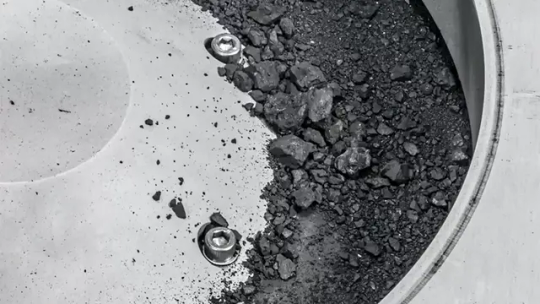
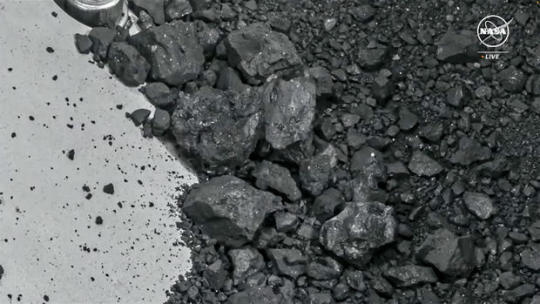
NASA’s Bennu Asteroid Sample
More carbon than expected and an abundance of water were found in the 4.5-billion-year-old asteroid sample returned to Earth by OSIRIS-REx. The two combined could mean that the building blocks for life on Earth might be locked in these rocks.
#NASA’s Bennu Asteroid Sample#OSIRIS-REx#nasa#nasa photos#nasa picture of the day#space#spaceship#spacecraft#solar system
74 notes
·
View notes
Text
Touchdown! Alien Rock Returned from Billions of Miles Away!

After traveling billions of miles to Bennu and back, the OSIRIS-REx spacecraft released its sample capsule toward Earth’s atmosphere at 6:42 a.m. EDT (4:42 a.m. MDT). The spacecraft was 63,000 miles (102,000 kilometers) from Earth’s surface at the time – about one-third the distance from Earth to the Moon.
Traveling at 27,650 mph (44,500 kph), the capsule pierced the atmosphere at 10:42 a.m. EDT (8:42 a.m. MDT), off the coast of California at an altitude of about 83 miles (133 kilometers). Within 10 minutes, it landed on the military range. Along the way, two parachutes successfully deployed to stabilize and slow the capsule down to a gentle 11 mph (18 kph) at touchdown
“The returned samples collected from Bennu will help scientists worldwide make discoveries to better understand planet formation and the origin of organics and water that led to life on Earth, as well as benefit all of humanity by learning more about potentially hazardous asteroids”
After years of anticipation and hard work by NASA’s OSIRIS-REx (Origins, Spectral Interpretation, Resource Identification and Security – Regolith Explorer) team, a capsule of rocks and dust collected from asteroid Bennu finally is on Earth. It landed at 8:52 a.m. MDT (10:52 a.m. EDT) on Sunday, in a targeted area of the Department of Defense’s Utah Test and Training Range near Salt Lake City.
Within an hour and a half, the capsule was transported by helicopter to a temporary clean room set up in a hangar on the training range, where it now is connected to a continuous flow of nitrogen.
Getting the sample under a “nitrogen purge,” as scientists call it, was one of the OSIRIS-REx team’s most critical tasks today. Nitrogen is a gas that doesn’t interact with most other chemicals, and a continuous flow of it into the sample container inside the capsule will keep out earthly contaminants to leave the sample pure for scientific analyses.
76 notes
·
View notes
Text
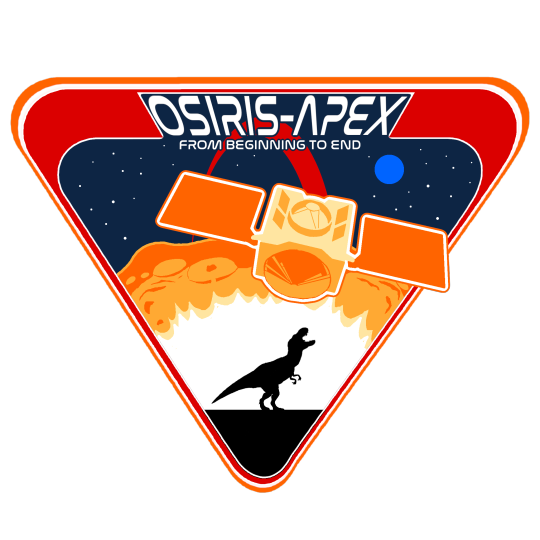
A quick badge design I did to celebrate the successful return of samples from asteroid Bennu, and the beginning of the OSIRIS-APEX mission!
For context, after OSIRIS-REx dropped the samples off, it was renamed and has now begun a new mission to explore a new hazardous asteroid, the infamous asteroid Apophis!
This badge celebrates the shift from investigating the ways asteroids may seed life, to how they can threaten it.
29 notes
·
View notes
Text

OSIRIS-REx sample return
46 notes
·
View notes
Text

This is the exact moment OSIRIS-REx became OSIRIS-APEX
Anyways, congratulations to NASA and Lockheed Martin for successfully recovering OSIRIS-REx's sample return capsule, containing asteroid samples from Bennu! With that mission done, OSIRIS-REx is not redesignated as OSIRIS-APEX, with the new mission of exploring the near-Earth asteroid of Apophis! Safe travels OSIRIS-APEX!
----------------------------------------
Like my art? Consider supporting me on Ko-fi!
#Art#Random Art#MLP#My Little Pony#MLP Art#Space#Space Art#OSIRIS-REx#OSIRIS-APEX#NASA#Asteroids#My Little Pony Art
18 notes
·
View notes
Text
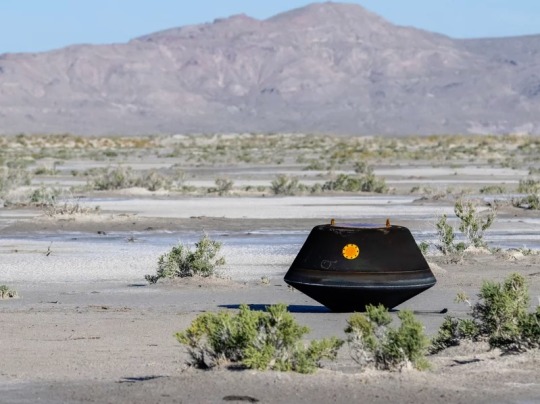
The sample return capsule from NASA's OSIRIS-REx mission, blackened from its fiery reentry through the atmosphere, shortly after touching down in Utah, September 24, 2023.
15 notes
·
View notes
Text
youtube
We're going to get a physical sample of an asteroid returned to the Earth this Sunday, September 24, 2023.
#osiris-rex#asteroid#asteroid bennu#sample return#tagsam#nasa#astronomy#planetary science#space#space exploration#space probe#september 24#nasa loves their acronyms#need another silly acronym#Youtube
13 notes
·
View notes
Text
To Bennu and Back - A Personal Voyage
The following was originally posted to my Medium on November 5, 2023. I figured the good people of Tumblr would enjoy a story, and some ramblings from my mind - so here we go. Please do remember to check me out elsewhere, most social media I have is under the same "nikproxima" handle. Without further adieu...
Today, in a rare moment of free time, I went and spent an hour in a museum. The Smithsonian’s Museum of Natural History has, for a long time, been a place where I’ve come to marvel at the wonders of our world — a place that shaped my long standing appreciation for science and technology. But today, I went to see a visitor from another world, a visitor who in many ways I had already met a few months prior — a piece of the asteroid Bennu, delivered to Earth by NASA’s OSIRIS-REx spacecraft.
I remember how cold it was that morning, deep in the salt flats of Utah, away from the lights and bustle of Salt Lake City. September in the desert is not always the kindest, it can be 80ºF or 30ºF all on the same day. It felt so alien, yet, somehow right for a pinpoint landing from deep space. My photographer Matt and I left the sprawling suburbs behind as we wove through the mountains and brine filled pools, singing along to music we had discovered a mutual interest in. The dark voids of landforms stood over us as we negotiated the twisting freeways, soon spitting us onto a two lane highway. We spent an hour and a half on our drive, checking and rechecking NASA’s Twitter for information about the mission until my cell service was reduced to one bar. There was a degree of confidence not found in rocket launches present that morning. We’d both covered launches in the past, and were acutely aware of the sensitivity of these great machines. Delays are the name of the game, but not today. This was happening, and we were powerless to stop it should anything go wrong.
The road we had taken through the inky expanse was narrow and dark, not a light to be seen. Only the ever dimming glow of the city we had left behind, and the ever brightening stars above us. We tried our best to pick out constellations and planets, craning our necks to see through the windshield. It was an alien world, and we were diving head first into it. There are no lights welcoming you to a military proving ground, only signs for you to stay away. Dugway is not exactly a friendly place, a complex and deeply secure military base lodged in the hostile flat expanse of the desert. Every element of our arrival was strange, the friendly welcome of NASA and University of Arizona officials contrasted strongly by the Army personnel. I can only imagine how strange it would have been for the staff of this isolated facility, watching a gaggle of press officials descending upon them.
As we filed in, through checkpoint after checkpoint, we found ourselves cemented in the thick of it. Officials from NASA, Dugway and UofA were eagerly counting off milestones. The spacecraft, having deposited its precious cargo, conducted its diversion maneuver as we sat on the dark and cold bus out the press site — truly alone. The spacecraft was off on the next part of its grand adventure, an exploration of the asteroid Apophis. But we were alone, just like those precious samples hanging over our heads. The press site was still dark when we arrived there, floodlights from the airfield bathing it in an eerie artificial glow as the sun threatened to creep over the distant mountains. Matt and I were quick to scour the place for a cup of coffee. The press tent was warm, warm enough to threaten to lull you to sleep — but there was too much excitement in the air. We were here, where we were meant to be, and those samples were coming. The flight line was adorned with helicopters, sleeping beasts equipped with cameras and other sensors to hunt for this precious treasure from deep space. We had a long wait before showtime.
I spent a good portion of this time speaking with Dr. Danny Glavin, from Goddard Space Flight Center in Maryland. Many of the questions he faced centered around the upcoming Mars Sample Return mission, a complex and expensive program proving to be a headache for many involved. He spoke to me with a genuine kindness and excitement for this mission, and missions to come. The desert’s silence was broken by the sound of rotor blades, as the four helicopters came to life, beginning their trek towards the staging area. This was a complex operation, practiced over the 7 years this spacecraft had been roaming the Solar System — becoming all too real this chilly September morning. It was getting closer now, closing seemingly impossible distances over our heads. I cannot describe the emotion I felt as the last helicopter left, threatening to topple us with the force of its rotor wash— somewhere between excitement and dread.
Somewhere up above us, two additional aircraft joined the hunt. A WB-57 and a modified Gulfstream business jet, each equipped with heat seeking and high resolution cameras, began orbiting the landing site in search of their prize. In the tent, we counted down the seconds until the start of entry interface, the moment in which the samples would make first contact with the atmosphere — watching the landing timer tick towards zero. In the skies of Utah, the SRC was suddenly met with the force of the atmosphere once more, something it last felt 7 years prior at liftoff. This is where I felt the extent of my helplessness, watching this tiny blip on the 57’s FLIR imager. In that moment, I felt truly united with everyone in the room — sitting in wait, and clinging to hope. The press site was dead silent, save for the commentary from the livestream being broadcast to the world a few hundred feet from us. I was busy tweeting, commenting everything that I heard and saw from the official Space Scout Twitter. I think I wanted to throw up the entire time, and could only barely bring myself to look. At 7:39 from landing, we heard it: “PARACHUTE DEPLOYMENT”. The press site felt energized, whoops and cheers, but there were milestones still to come, and the crash of the Genesis mission all those years ago still sat in our minds.
I don’t think the fear stopped until we touched down. The footage was too grainy for us to really make out what was happening against the desert, obscuring the SRC from view. Hearing “CONFIRMATION OF SRC TOUCHDOWN” was unlike anything I had ever felt. I had watched robots land on Mars, ships launch to the International Space Station, but this was here, returning to Earth. What a unique accomplishment that was, to not only make the trek across our Solar System, but to return to the place that created it. As the chute settled, and the teams were able to get closer, the noise returned. The press site was alive once more, people hugged and cried — all overjoyed with a sense of pride and achievement. Humans combined all their knowledge and brain power and talent and built this spacecraft, sent it to an asteroid a billion miles away, beat the odds, rethought our knowledge of the solar system, all before making the billion mile voyage back in order to get something that weighs less than a baseball into labs around the world. We were home.
It was, however, a strange homecoming. Coming home to a planet so different from how it was 7 years ago. So much had changed, as is the case in the information age. A globally connected world moves rapidly, and change is all around us — Nowhere was the notion of a pandemic, war, let alone the personal change in my life. Scientists describe samples like this as a time capsule of sorts, a look deep into our past to tell us what we’re truly made of, a unique and untouched look to how things once were. In 2016, when OSIRIS-REx lifted off, I was just starting college, a nervous wreck of an individual not quite ready for the real world. I was so unsure of what I wanted to do, I spent months agonizing about myself, my identity and the meaning of it all. But spaceflight distracted me, and ultimately motivated me towards my goal of telling stories and being a part of it. I watched this mission launch from my freshman dorm room, unable to fathom that 7 years later I would be at its landing, waiting with open arms for this precious piece of the universe to be returned. As the samples were flown back under the long line of the helicopters, a strange feeling started to creep over me. A great cosmic emptiness, a feeling that everything that I did was in vain, that despite my presence for this tremendous event, it was all for nought. This new fear, one of failure and regret, threatened to overpower me. I found myself far less social, drawing the curtain around myself — no longer as excited to be there. As we left the press site after a safe delivery, and said goodbye to all of our new friends, a strange feeling of emptiness settled over me.
My trip back to Washington was full of this line of thinking. I spent a good amount of time wondering about the scale of it all, feeling smaller than I ever had as I stared out the window of the ancient 757 that carried me home. The vast distances of the cosmic ocean, for the first time, threatened to overwhelm me and swallow me whole. Work quickly picked back up for me, and I made preparations to leave for the launch of NASA’s Psyche mission, a voyage to a metal world that alongside OSIRIS-REx, aimed to unlock the secrets of our solar system. But something still remained, this fear of the great unknown. Even as the spacecraft left the pad, I could not help but think back to the Utah desert, and the growing fear of the dark.
It was not until November 5 that I realized that this fear sitting in my gut was not some great eldritch horror. I was not afraid of the unknown, rather, I was afraid of my own change. This unusually warm November afternoon, I braved Red Line closures and crowds to catch a glimpse of the OSIRIS-REx sample, a measly fraction of what had been scooped up from this distant world. It was, in many ways, unremarkable. A grey rock sitting in a grey container in a glass case, flanked by models of the spacecraft and the Atlas rocket that launched it all those years ago. No longer was it separate from me, some unknowable cosmic entity, but a thing I could perceive. I did not stay long, taking only a few pictures before stepping out into the autumn breeze — but I found myself unable to go very far.
That fear, the one I had equated to the unknown for so long, was revealing its true form to me in that moment. It was a fear of change, a fear of the rapid progression of my life, a fear of growing old — where this cosmic morsel was already ancient. It had survived for hundreds of thousands of lifetimes, perhaps even longer than humans had been on this planet, and it had remained largely unchanged. It was so immune to change, until it was literally plucked from the heavens and brought back to Earth. And then I realized — the change that we enacted on this speck from space opens our world, changes our line of questioning, enables us to uncover more about our past. And that’s what change is like at the human level, too. Without this change, I would not be who I am today, a person shaped by experiences; triumph and defeat. I would not have the ability to question my world, and shape my inquiry as I have without change. For so long, I struggled to find a purpose — often curious as to why I was even here. Truth be told, I may never know the answer. But these great cosmic moments in life, be it a rocket launch, a sample return, or getting the chance to talk to the people who will be voyaging to the moon, remind me that change is part of it all. That’ll help me sleep at night, I think.
#writing#space#science#osiris-rex#travel#journalism#exploration#personal#emotional#science communication#scicomm#outreach
3 notes
·
View notes
Text
Asteroid Treasure: OSIRIS-REx returns with Bennu samples
The samples returned from asteroid Bennu are safely contained in the sample return capsule following its parachute-assisted touchdown in the Utah desert. Credit: NASA
After a seven-year, 3.86-billion-mile odyssey, NASA’s OSIRIS-REx mission successfully delivered to Earth samples from asteroid Bennu.
Continue reading Untitled

View On WordPress
4 notes
·
View notes
Text

A little while ago, the samples taken from the asteroid Bennu brought back to Earth by NASA's OSIRIS-REx space probe were collected by the American space agency's crew in the area of their landing, at the Utah Test and Training Range. They will be transported to the Johnson Space Center, the first stage of a series of operations needed to process them while avoiding their contamination. In this study, NASA is collaborating with the Japanese space agency JAXA, which will receive some of the samples to compare them with those collected by its own Hayabusa 2 space probe on the asteroid Ryugu and returned to Earth in December 2020.
3 notes
·
View notes
Text

"Hi there!"
2 notes
·
View notes
Text
A Very Important and Special Box of Rocks 🪨
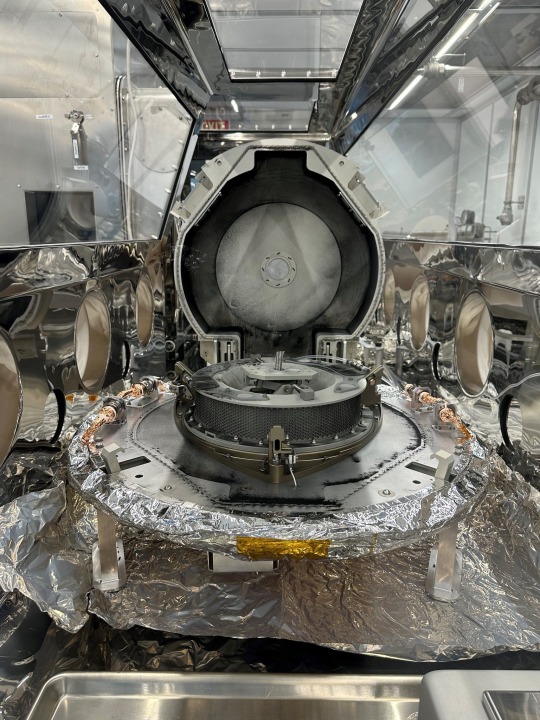
NASA’s OSIRIS-REx (Origins, Spectral Interpretation, Resource Identification and Security – Regolith Explorer) has been opened!
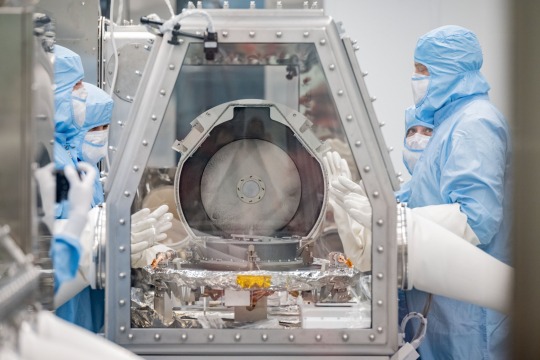
NASA scientists found black dust and debris on the avionics deck of the OSIRIS-REx science canister when the initial lid was removed today. The canister from the OSIRIS-REx sample return capsule was delivered to NASA’s Johnson Space Center in Houston on Sept. 25 after landing in the Utah desert on Sept. 24
With an array of team members on deck, scientists and engineers at Johnson will work together to complete the disassembly process and reveal the sample to the world in a special live broadcast event on Oct. 11 at 11 a.m. ET, streamed at NASA.gov/live
3 notes
·
View notes
Text

sampler
0 notes
Text
Trei semne apocaliptice
youtube
View On WordPress
0 notes
Text
Asteroid Bennu might strike Earth. Will the rock sample prove useful in preventing a collision?
Scientists have predicted that Asteroid Bennu, which passes by Earth every six years in its orbit, has a 1 in 2700 chance of striking Earth in 2182.
Bennu has been on NASA’s radar for 25 years, first discovered by their Lincoln Near-Earth Asteroid Research (LINEAR) survey in 1999. Bennu is only slightly taller than the Empire States Building, weighing a staggering 78 billion kilograms and…
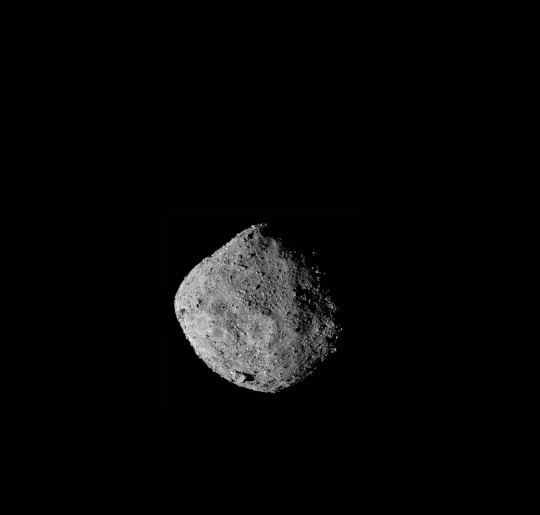
View On WordPress
0 notes
Text
Water From Space In Bennu First Look
The OSIRIS-REx mission collected rock and dust from the asteroid Bennu in 2020 and today NASA gave it’s first report on the intriguing space rock. A separate capsule containing the interplanetary cargo parachuted to Earth a little over two weeks ago, landing in the Utah desert on September 24th, on target.
The 4.5 billion year old asteroid was created before the solar system, and we now know is…

View On WordPress
0 notes